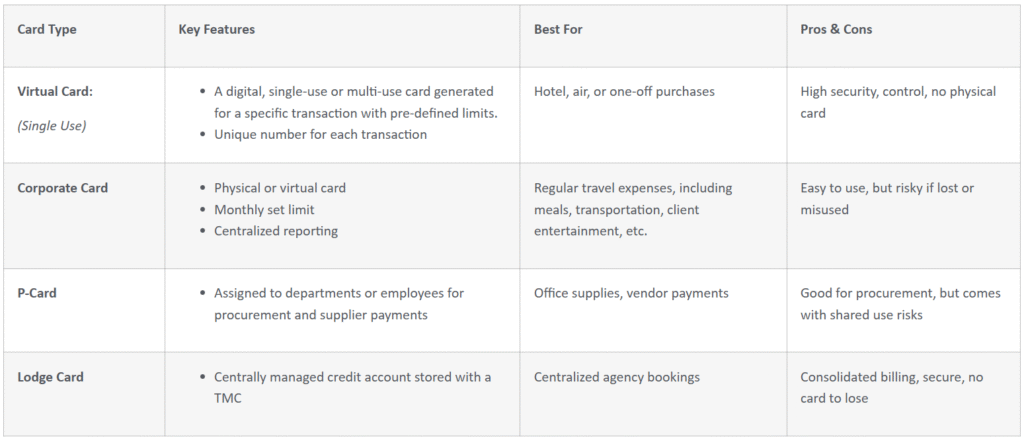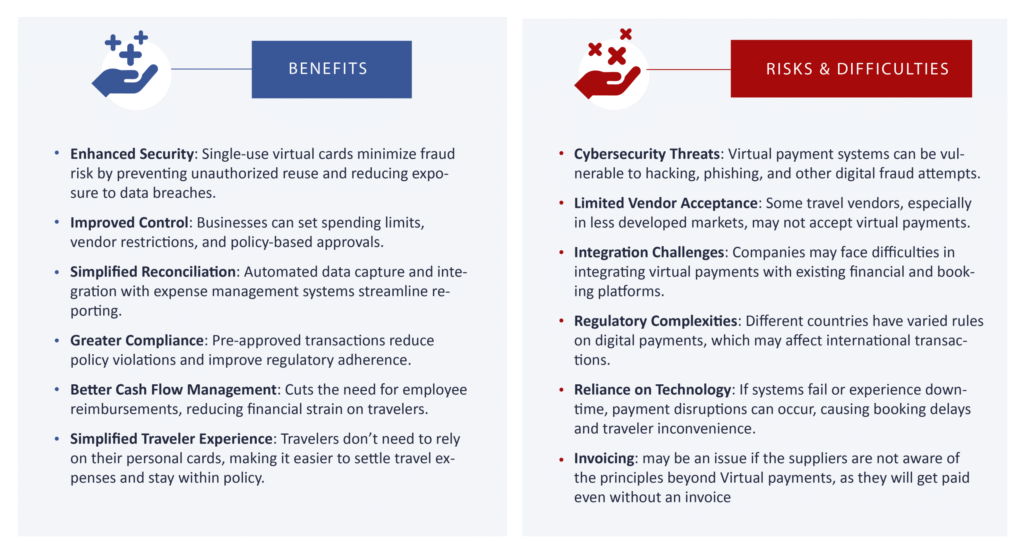
The settlement of business travel is a critical part of corporate operations, but traditional payment methods can be complex – creating inefficiencies, security risks, and compliance challenges.
Virtual payment solutions have appeared to be a game-changer, offering a smarter, safer, and more streamlined way to pay for corporate travel. This shift is driving significant market growth, with the global virtual cards market valued at approximately USD 19 billion in 2024 and projected to reach USD 90 billion in 2033—a compound annual growth rate (CAGR) of approximately 20 %over the period.
In this blog, we will explore the challenges of traditional corporate travel payments, the virtual payment solutions available today, and how businesses can implement and improve these technologies.
Why Traditional Payments Fall Short
Inefficiencies in Managing Corporate Travel Expenses
Managing travel expenses with traditional credit cards and reimbursement processes is time-consuming. Manual reporting, receipt tracking, and reconciliation cause administrative burdens, leading to delayed reimbursements and financial discrepancies.
Fraud Risks and Security Concerns with Physical Cards
Corporate cards can be lost, stolen, or misused, posing security risks. Additionally, fraudulent transactions and unauthorized spending are familiar challenges, particularly when employees share card details with third parties or vendors.
Difficulty in Tracking and Reconciling Payments Across Multiple Vendors
Businesses often struggle to track and combine payments across airlines, hotels, car rentals, and travel agencies. Without centralized tracking, it becomes difficult to enforce compliance and ensure correct expense reporting.
The Rise of Unmanaged Spend, Especially for Last-Minute or Infrequent Travelers
Occasional travelers, consultants, and remote employees may not have access to corporate cards, leading to out-of-pocket expenses or unmanaged spending. Last-minute travel bookings can further complicate budget control and policy enforcement.
Types of Cards and What Sets Virtual Apart
Virtual cards, corporate cards, purchasing cards, and lodge cards all serve different purposes in corporate travel and expense management. Here is a breakdown of their key differences:

What Virtual Payment Solutions Offer Today and the Challenges They Bring
Whether you are using a single use card or a multi-use lodge card for travel bookings through your TMC, there are several benefits, including:
- Seamless integrations with travel booking platforms and expense management systems, enabling real-time tracking, automated reconciliation, and compliance enforcement.
- Enhanced capabilities through fintech innovations, such as API-based payment solutions and AI-driven fraud detection, enabling real-time payment tracking and automated approvals for greater oversight.
- Enhanced control, security, and compliance through pre-set spending limits and restrictions, unique card numbers to prevent fraud, and automated data capture for simplified regulatory adherence and reporting.

Regional Trends in Virtual Card Adoption
Virtual card adoption is accelerating globally, but the pace and drivers vary by region.
- Europe currently leads the global market, accounting for nearly 38% of revenue in 2023, with Germany and the UK embracing virtual cards due to widespread digital payment infrastructure and smartphone usage.
- The Asia-Pacific region is the fastest-growing, fueled by rapid digital transformation, increased internet access, and a rising middle class.
- In North America, a mature banking system and openness to financial innovation have helped virtual cards gain early traction, particularly in the U.S.
- Meanwhile, Latin America is emerging as a growth region, with Brazil and Mexico advancing digital payments through financial inclusion initiatives.
These regional dynamics highlight the need for globally scalable virtual payment solutions that can flex to local market realities.
Getting Started or Optimizing Your Virtual Payments Approach
- Assess your current payment landscape and find gaps and pain points: Evaluating your existing travel payment processes will help pinpoint inefficiencies and show security risks or compliance issues.
- Engage key stakeholders, including Travel, Finance, Procurement, and IT: Collaborating across departments ensures alignment in selecting a virtual payment solution that meets financial, operational, and security needs.
- Choose the right virtual payment solution by considering integration, global acceptance, and policy alignment: Selecting a provider that integrates seamlessly with existing travel and expense management systems, supports international transactions, and aligns with corporate policies.
- Educate travelers and suppliers to ensure smooth adoption and compliance: Train employees and vendors on how to use virtual payments, emphasizing benefits such as security, ease of use, and policy adherence.
- Monitor and refine – Leveraging data insights to refine usage and reporting: Regularly analyze transaction data to show trends, improve travel spending, and improve policy compliance.
The Future of Virtual Payments in Business Travel
Virtual payments are rapidly evolving, driven by several key trends:
- AI and machine learning will boost fraud detection, automate reconciliation, and improve expense forecasting.
- Mobile payment solutions will streamline transactions and enhance the traveler experience.
- As remote work and hybrid travel increase, virtual payments will support dynamic policies, offering travelers greater flexibility while keeping financial oversight.
Looking ahead, we expect to see:
- Greater adoption of real-time payment solutions
- Expansion of biometric and tokenized payment security
- Increased regulatory frameworks supporting virtual payment adoption.
Conclusion
Virtual payments are revolutionizing business travel by addressing inefficiencies, enhancing security, and streamlining expense management. While risks exist, proper implementation and continuous monitoring can mitigate challenges, making virtual payments an asset for corporate travel management. Companies that adopt and improve virtual payment solutions will gain a competitive edge, improving both traveler experience and financial control. Now is the time to evaluate your payment landscape and embrace the future of corporate travel payments.
Sources:






